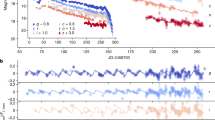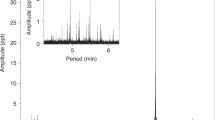Abstract
Type Ia supernovae are thermonuclear explosions of white dwarf stars in close binary systems1. They play an important role as cosmological distance indicators and have led to the discovery of the accelerated expansion of the Universe2,3. Among the most important unsolved questions4 about supernovae are how the explosion actually proceeds and whether accretion occurs from a companion or by the merging of two white dwarfs. Tycho Brahe’s supernova of 1572 (SN 1572) is thought to be one of the best candidates for a type Ia supernova in the Milky Way5. The proximity of the SN 1572 remnant has allowed detailed studies, such as the possible identification of the binary companion6, and provides a unique opportunity to test theories of the explosion mechanism and the nature of the progenitor. The determination of the hitherto unknown7,8,9 spectroscopic type of this supernova is crucial in relating these results to the diverse population of type Ia supernovae10. Here we report an optical spectrum of Tycho’s supernova near maximum brightness, obtained from a scattered-light echo more than four centuries after the direct light from the explosion swept past the Earth. We find that SN 1572 belongs to the majority class of normal type Ia supernovae.
This is a preview of subscription content, access via your institution
Access options
Subscribe to this journal
Receive 51 print issues and online access
$199.00 per year
only $3.90 per issue
Buy this article
- Purchase on SpringerLink
- Instant access to full article PDF
Prices may be subject to local taxes which are calculated during checkout



Similar content being viewed by others
References
Nomoto, K., Thielemann, F.-K. & Yokoi, K. Accreting white dwarf models of Type I supernovae. III - Carbon deflagration supernovae. Astrophys. J. 286, 644–658 (1984)
Riess, A. G. et al. Observational evidence from supernovae for an accelerating universe and a cosmological constant. Astron. J. 116, 1009–1038 (1998)
Perlmutter, S. et al. Measurements of Omega and Lambda from 42 high-redshift supernovae. Astrophys. J. 517, 565–586 (1999)
Hillebrandt, W. & Niemeyer, J. C. Type Ia supernova explosion models. Annu. Rev. Astron. Astrophys. 38, 191–230 (2000)
Baade, W. B Cassiopeiae as a supernova of type I. Astrophys. J. 102, 309–317 (1945)
Ruiz-Lapuente, P. et al. The binary progenitor of Tycho Brahe’s 1572 supernova. Nature 431, 1069–1072 (2004)
Ruiz-Lapuente, P. Tycho Brahe’s supernova: light from centuries past. Astrophys. J. 612, 357–363 (2004)
van den Bergh, S. Was Tycho’s supernova a subluminous supernova of type Ia? Astrophys. J. 413, 67–69 (1993)
Schaefer, B. The peak brightnesses of historical supernovae and the Hubble constant. Astrophys. J. 459, 438–454 (1996)
Branch, D. et al. Comparative direct analysis of type Ia supernova spectra. II. Maximum light. Publ Astron. Soc. Pacif. 118, 560–571 (2006)
Brahe, T. in Opera Omnia Vol. 2 (ed. Dreyer, I. L. E.) 307 (Swets & Zeitlinger, 1972)
Doggett, J. B. & Branch, D. A comparative study of supernova light curves. Astron. J. 90, 2303–2311 (1985)
Decourchelle, A. et al. XMM-Newton observations of the Tycho supernova remnant. Astron. Astrophys. 365, L218–L224 (2001)
Krause, O. et al. Infrared echoes near the supernova remnant Cas A. Science 308, 1604–1606 (2005)
Rest, A. et al. Scattered-light echoes from the historical galactic supernovae Cassiopeia A and Tycho (SN 1572). Astrophys. J. 681, L81–L84 (2008)
Krause, O. et al. The Cassiopeia A supernova was of type IIb. Science 320, 1195–1197 (2008)
Rest, A. et al. Spectral identification of an ancient supernova using light echoes in the Large Magellanic Cloud. Astrophys. J. 680, 1137–1148 (2008)
Filippenko, A. Optical spectra of supernovae. Annu. Rev. Astron. Astrophys. 35, 309–355 (1997)
Nugent, P., Kim, A. & Perlmutter, S. K-corrections and extinction corrections for type Ia supernovae. Publ Astron. Soc. Pacif. 114, 803–819 (2002)
Filippenko, A. et al. The subluminous, spectroscopically peculiar type IA supernova 1991bg in the elliptical galaxy NGC 4374. Astron. J. 104, 1543–1556 (1992)
Filippenko, A. et al. The peculiar type IA SN 1991T - Detonation of a white dwarf? Astrophys. J. 384, L15–L18 (1992)
Phillips, M. M. et al. The reddening-free decline rate versus luminosity relationship for type Ia supernovae. Astron. J. 118, 1766–1776 (1999)
Völk, H. et al. Internal dynamics and particle acceleration in Tycho’s SNR. Astron. Astrophys. 483, 529–535 (2008)
Gonzalez Hernandez, J. et al. The chemical abundances of Tycho G in supernova remnant 1572. Astrophys. J. (in the press); preprint at 〈http://arxiv.org/abs/0809.0601〉 (2008)
Mazzali, P. A. et al. High-velocity features: A ubiquitous property of type Ia supernovae. Astrophys. J. 623, L37–L40 (2005)
Wang, L. et al. Spectropolarimetry of SN 2001el in NGC 1448: Asphericity of a normal type Ia supernova. Astrophys. J. 591, 1110–1128 (2003)
Mattila, S. et al. Early and late time VLT spectroscopy of SN 2001el — progenitor constraints for a type Ia supernova. Astron. Astrophys. 443, 649–662 (2003)
Kasen, D. et al. Analysis of the flux and polarization spectra of the type Ia supernova SN 2001el: Exploring the geometry of the high-velocity ejecta. Astrophys. J. 593, 788–808 (2003)
Tanaka, M. et al. Three-dimensional models for high-velocity features in type Ia supernovae. Astrophys. J. 645, 470–479 (2006)
Sparks, W. B. et al. V838 Monocerotis: a geometric distance from Hubble Space Telescope polarimetric imaging of its light echo. Astron. J. 135, 605–617 (2008)
Acknowledgements
This work is based on data collected at the Subaru Telescope, which is operated by the National Astronomical Observatory of Japan, and the German–Spanish Astronomical Center, Calar Alto, jointly operated by the Max-Planck-Institut für Astronomie Heidelberg and the Instituto de Astrofísica de Andalucía. We thank U. Thiele and the Calar Alto observers for their support. M.T. is supported by the Japan Society for the Promotion of Science Research Fellowship for Young Scientists. This research has been supported in part by the World Premier International Research Center Initiative, MEXT, Japan.
Author information
Authors and Affiliations
Corresponding authors
Rights and permissions
About this article
Cite this article
Krause, O., Tanaka, M., Usuda, T. et al. Tycho Brahe’s 1572 supernova as a standard type Ia as revealed by its light-echo spectrum. Nature 456, 617–619 (2008). https://doi.org/10.1038/nature07608
Received:
Accepted:
Published:
Issue Date:
DOI: https://doi.org/10.1038/nature07608
This article is cited by
-
A solar-type star polluted by calcium-rich supernova ejecta inside the supernova remnant RCW 86
Nature Astronomy (2017)
-
No hot and luminous progenitor for Tycho’s supernova
Nature Astronomy (2017)
Comments
By submitting a comment you agree to abide by our Terms and Community Guidelines. If you find something abusive or that does not comply with our terms or guidelines please flag it as inappropriate.



